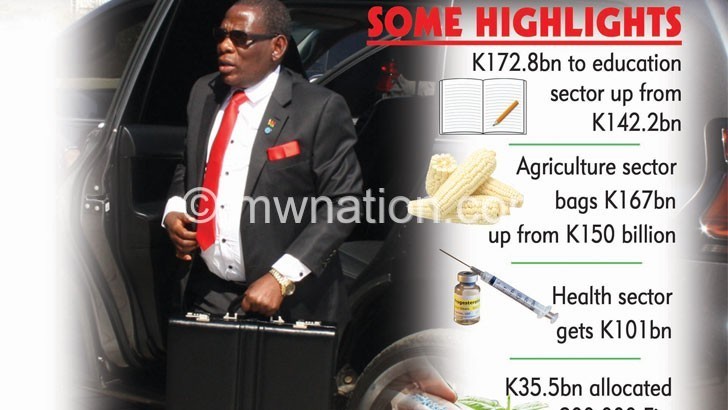Mwanamvekha unveils K1.7tn maiden budget
Economic experts and other development partners have described the 2019/20 National Budget as a ‘cautious’ financial plan.
Minister of Finance, Economic Planning and Development Joseph Mwanamvekha on Monday presented his maiden full budget whose nominal value in terms of total expenditure has been pegged at K1.7 trillion, representing 27.6 percent of gross domestic product (GDP).

—Photo: Ras Peter Kansengwa
The budget—which Mwanamvekha, throughout his presentation, repeatedly said is anchored on ensuring debt sustainability, inclusive growth as well as economic empowerment—is an increase of 20.1 percent from the 2018/19 preliminary outcome of K1.4 trillion.
Out of the total planned expenditure, K1.3 trillion, which is 20.6 percent of GDP, is under recurrent expenditure while K437.9 billion (representing 7.0 percent of GDP) is provided for the development budget.
At 7 percent of GDP, development expenditure in the 2019/20 Budget is the highest in recent years, as in the 2018/19 Budget, development spending was revised to 5.7 percent of GDP while in the previous financial year of 2017/18, it was recorded at 4.6 percent of the country’s total wealth as measured but GDP.
On one hand, recurrent expenditure in the budget now comprises K443.4 billion for wages and salaries; K244.0 billion for interest payments; and K290.9 billion for goods and services.
However, in the budget, Mwanamvekha is thoughtful about the need to cut the monstrous high public debt, which he admitted has been tormenting Capital Hill due to high perpetual budget deficits.
The budget has substantially reduced the wider gap between revenues and expenditure or simply the deficit to K155.9 billion or 2.5 percent of GDP, and this is a reduction of about 51.3 percent from the 2018/19 preliminary actual budget deficit outturn of K320.2 billion.
This, according to economic analysts that we spoke to yesterday soon after budget presentation, is a cautious move by Treasury to avoid the accumulation of both external and domestic debt.
“The 2019/20 projected deficit will be financed by net foreign borrowing amounting to K109.7 billion and a domestic borrowing of K46.1 billion. Honourable Members, as you will observe from the numbers, the 2019/20 Budget has been prepared with the objective of reducing domestic borrowing in order to reduce public debt,” Mwanamvekha proclaimed.
In the budget, total revenue and grants have been projected at K1.6 trillion, representing 25.1 percent of GDP, and this is an increase of 26.1 percent from the 2018/19 approved amount of K1.3 trillion.
Optimism on key macroeconomic indicators
The budget also clearly reflects some optimism from Treasury, at least if the key assumptions underpinning the budget are anything to go by.
The fiscal plan envisages an estimated real economic growth rate of 5.0 percent in 2019 and 7.0 percent in 2020.These projections are way above the projected sub-Saharan real GDP growth rate of 3.4 percent in 2019 and 3.6 percent in 2020.
In fact, Malawi’s projected real GDP growth rates are way above the global projected growth rates of 3.2 percent in 2019 and 3.5 percent in 2020, according to the World Economic Outlook (WEO) report, published by the International Monetary Fund (IMF) in July this year.
Such ambitious growth rates, if attained, could boost donor and investor confidence while increasing private sector activity.
In the budget, Mwanamvekha is also firm of his earlier ambitious targets of bringing average inflation rate of 8 percent during the fiscal year, maintaining a stable exchange rate of about K750 to a United States (US) dollar, while also putting the policy rate—the rate at which commercial banks borrow money from the Reserve Bank of Malawi (RBM)—steady at 13.5 percent.
Treasury smiles at civil servants
In the budget, government appears to have succumbed to growing pressure from civil servants as it has budgeted a salary increment of between 10 percent to 15 percent.
The arrangement is that lower grades in the civil service are expected to get relatively higher salary increments than the high ranking grades.
That alone automatically pushes government’s total wage bill to K443.4 billion from K393.6 billion, representing a 12.6 percent increase.
At K443.4 billion, the wage bill is 7.1 percent of GDP, and this is not a deviation from the 2018/19 Budget whose wages and salaries were revised to 7.2 percent of GDP.
The Nation understands that government’s wage bill should not exceed 9 percent of GDP, estimated at around $7 billion (about K5.2 trillion) and this is premised within the Malawi’s agreement with the IMF, under the fund’s supported programme, the Extended Credit Facility (ECF).
Freeing some more disposable income
Faced with growing calls to adjust upwards the Pay As You Earn (Paye) tax-free bracket during pre-budget consultations, government has increased the tax free band by K10 000 from K35 000 to K45 000.The adjustment, according to Mwanamvekha, is on account of the sky-rocketing cost of living biting many average Malawians by freeing some more disposable income.
The budget has also increased the minimum wage from K25 012 per month to K35 000. This adjustment, the minister said, will help protect lowly paid workers and improve their welfare.
But as Mwanamvekha dreams of high economic growth rates coupled with an inclusive growth and economic empowerment, it is imperative that the minister is also wary of the continued political impasse that has unleashed a negative effect on the country’s economic growth.





